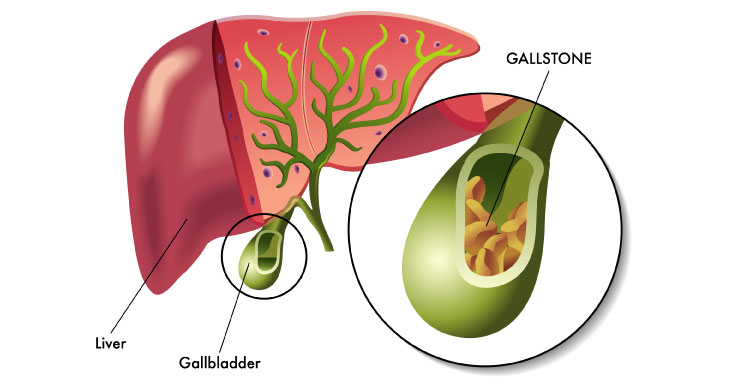A Brief Introduction To Gallstones And Gallstone Surgery
The gallbladder is a pear-shaped organ, located in the upper right side of the abdomen, right under the liver. It secretes bile juice, which helps in digestion. When this digestive enzyme solidifies, it forms hard, gallstones. Gallstones are of 2 types, cholesterol stones (when too much cholesterol is present in the bile) and pigment stones (when too much bilirubin is present in the bile). It is becoming very common these days and thus, a lot of hospitals are offering gallbladder stone surgery. Let’s understand some important aspects of the same, in details.
Symptoms Of Gallstones
Gallstones can arise in any number or size. Thus, the exact symptoms vary greatly from person to person. Many a time, gallstones might not project any symptoms at all (known as silent gallstones). However, the most common symptoms of gallstones are as follows and can persist anywhere between a few minutes to a few hours-
- Intense pain in the middle abdomen
- Pain in the right upper abdomen
- Pain in the right shoulder or between shoulder blades
- Nausea and vomiting
Though these symptoms can arise due to other conditions as well, if it persists for more than 2-3 weeks, it is best to get it evaluated to know the exact reason.
Causes Of Gallstones
Gallstones can happen to anyone. But few risk factors uplift the chances very much. These include-
- Having a family history of gallstones
- Having a personal history of gallstones
- Being overweight or obese
- Being pregnant
- Being 40 years or more
- Being female
- Being on a crash diet for weight loss
- Eating too spicy/oily food
- Eating a low-fiber diet
- Leading a sedentary lifestyle
- Having high cholesterol
- Having liver diseases
- Having diabetes
- Losing weight rapidly
- Taking medicines containing estrogen (like oral contraceptives)
It is important to evaluate oneself whether or not they are at risk of having gallstones. As a preventive measure, losing weight slowly, maintaining healthy body weight, and leading a healthy lifestyle is helpful to reduce the chances of the same.
What Is The Treatment For Gallstones?
If gallstones are left untreated, these can lead to complications such as inflammation of the gallbladder, blockage of common bile duct/ pancreatic bile duct and rarely gallbladder cancer. Thus, it is crucial to seek treatment for it, on time.
Gallstones can be treated by oral medication, shock wave lithotripsy and gallbladder stone surgery. Oral medical and litho stock therapy removes the stones by dislodging them, but often it takes many years to treat it completely if there are many gallstones. Moreover, once the therapy or the medication stops, the gallstones recur and for some people, the therapy or medicines simply don’t work.
Thus gallbladder surgery often remains the only option to treat gallstones permanently. In this surgery, the gallbladder is removed altogether so that gallstone can never recur in the future. These days, many doctors offer laparoscopic gallstone surgery, which removes the gallstones (along with the gallbladder, if needed) through few minute incisions and thus offers many advantages over open gallstone surgery.
The suitable method of treatment is determined by the doctor, depending upon your symptoms, complication, and compatibility. Come at ILS Hospitals for consultation and to get safe and effective gallbladder stone surgery from highly skilled GI surgeons.
Do You Need A Gallbladder Surgery To Cure Your Gallstones?
Your occasional stomach pain and digestion troubles not resolving even with home remedies and over-the-counter medicines? Are you certain it is not your gallstones? Knowing the symptoms of the gallstones help with an early detection and thereby a timely treatment. Few patients do not even realize the presence of the gallstones unless they block the path of bile, triggering ‘gallstone attack’ and cause unbearable, sharp pain. To avoid any such trauma and complications, it is advised to undergo timely, elective gallbladder surgery, also known as a cholecystectomy.
8 out of 10 patients with underlying gallstones need to undergo cholecystectomy either as an elective or emergency procedure. Those who might never need any surgical cure have what is called the ‘silent gallstones’ and can manage it and have a normal life with mild medication and lifestyle change. However, those who are experiencing any symptoms of the same, are always advised to avail the surgery.
The gallstone surgery can be done either by open or by laparoscopic surgery technique. The procedure is finalized by having multiple diagnostic screenings. These include blood tests, MRI (HIDA), ultrasound scan and endoscopy. After this thorough evaluation, the doctor finalizes the surgery mode. Here we present a brief description of them both. In both the procedures, often the gallbladder is removed altogether to mitigate the possibilities of its recurrence of the gallstones in the future.
Open surgery – The surgery is carried out through 5-8 inch incision made near the site. After the procedure, the incision is again stitched up. Now, it is suggested only for those who have some severe gallbladder complication or are in their 3rd-trimester pregnancy.
Laparoscopic surgery – It is also known as minimally invasive surgery or keyhole surgery and is carried out through 4-5 minute incisions and with the help of the modern instruments. These include laparoscope, camera, cold light source, and many other assisting instruments. A well-experienced surgeon operates effectively with the assistance of this advanced surgery and offers multiple benefits to the patients. These include much lesser operative and postoperative infection, bleeding, pain and recovery time.
ILS Hospitals, being a pioneer of laparoscopic surgery in eastern India, offers this advanced surgical technique for the people suffering from gallstones. However, open gallbladder surgery is also offered for patients with complications. In case, you or any of your loved ones is suffering the pain of the same, come down to ILS Hospitals to resolve it for once and all.
Are You Having Gallstones? Know the Symptoms to be Sure
Do you experience episodes of abdominal pain from time to time? Are you also experiencing persistent digestive issues that won’t resolve with diet changes? Chances are high that you are suffering from gallstones. In case you are ruling out the possibility of the same, remember, most of the patients later going for gallbladder stone surgery admitted to experience no symptoms for a long period of time. Let’s discuss what gallstones are along with some of the warning signs of gallstones.
The gallbladder is a small organ located beneath the liver and it secretes digestive enzymes that facilitate digestion. It is called the bile. When it concentrates into hardened mass, it becomes what we call the gallstones. It can either occur as one large stone or several small ones. The size of the same ranges from sand granule to as big as a golf ball.
There are some ‘silent gallstones’ that have no symptoms associated with it and often does not require any treatment either. Check out for the following warnings of gallstones that indicates you might need to consider a gallbladder stone surgery later on.
-
A sharp pain for a brief period, which often is called an ‘attack’, is the most prominent symptoms of an underlying condition of gallstone.
-
These episodes can be separated by some period of times. It can range anywhere between days, weeks, months or even years.
-
Though the pain might onset unannounced at any time, it has often been found to onset after 30-40 minutes after consuming a highly processed junk food.
-
This pain usually starts very mild but slowly turns severe. It stays constant for some time, which can last anywhere between 1 to 6 hours.
-
The pain usually originates in the abdomen, which may later move to the right shoulder or back. It usually sets during late night and the sharp pain may even wake a person right away.
-
The digestion associated symptoms such as nausea, vomiting, bloating, indigestion, etc. are often seen in patients with gallstones.
-
Symptoms like jaundice, fever and persistent severe pain need to be addressed immediately as it might indicate a blocked duct due to the accumulation of gallstones.
Unfortunately, gallstones are often recurring in nature. Those with a history of the same is highly susceptible to have it again in the future. Thus, it is always recommended to seek consultation before and after a gallbladder stone surgery to take measures against it.
The Scope and Benefits of Laparoscopic Surgery
The laparoscopic surgery is an advanced surgical technique that overcomes several negative aspects of traditional open surgery. It is also known as MIS (minimally invasive surgery), Band-Aid surgery or Keyhole surgery. It is executed by making few minor incision, instead of making a large slit across the site.
Let’s have a look at few of its aspect and importance in the field of medical science.
The Procedure of Surgery
Though laparoscopic surgery can be executed for several domains, the most common ones are done in the abdominal region. After the anesthesia is administrated, the surgery begins by making a single incision first, through this a cannula in inserted and carbon dioxide is used to inflate the stomach. Though the abdomen does have some of it already, but often extra is pumped in order to make the surgery more convenient.
After the administration of carbon dioxide, the outer layer of the stomach inflates, creating enough working space for carrying out the surgery. Few more incisions are made through which other instruments, camera and light source etc. are inserted. The real-time feed and movements are tracked and displayed on the monitor in the Operation Theater.

The displayed images are of extremely high resolution and can easily be zoomed in and out and moved around for better visual and for carrying out the procedure. The part of the instrument extended outside the body can be moved accordingly to make the desired movement inside. These include making dissecting, stitching, perforating, stapling, collecting and extracting portions of dissected diseased organs.
After the completion of the procedure, nearby organs re-checked for any signs of possible damage or infection. Upon assurance, the instruments are retracted back and the gas is extracted back in order to retain the abdomen, its original shape.
Scope of Laparoscopy
Laparoscopy is a diagnostic as well as a surgical technique which can be used to assist surgeries in the following domains, such as
- Gallbladder surgery
- Small and large intestine surgery
- Orthopedics Surgery
- Hernia repair surgery
- Liver and pancreas surgery
- Appendix surgery
- Infertility treatment
- Reproductive organ surgery like Hysterectomy

As a diagnostic tool, it is helpful to check several medical aspects, without perforating the organ or making things worse. It is used for the following purpose
- To evaluate the effectiveness of any treatment or medication
- To evaluate the stage of any disease
- To check a polyp or tumor
- To release fluid or gas trapped in the abdominal cavity
- To collect tissue samples for biopsy
In a nutshell, it is the top-notch surgical approach that is replacing the traditional surgery these days.














